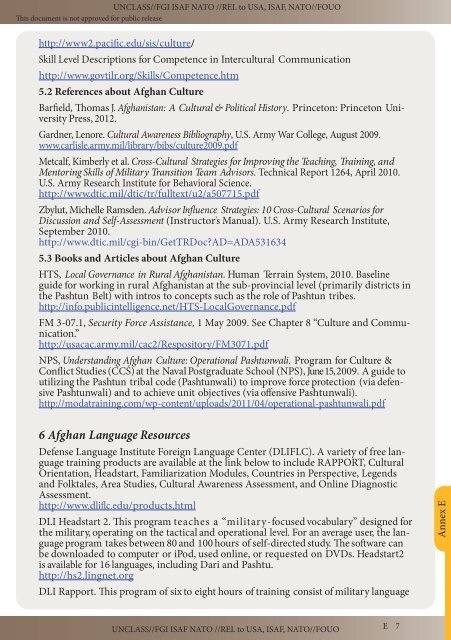20140927_NIU_CJ7_TREX_SFA guide 3.1
20140927_NIU_CJ7_TREX_SFA guide 3.1
20140927_NIU_CJ7_TREX_SFA guide 3.1
You also want an ePaper? Increase the reach of your titles
YUMPU automatically turns print PDFs into web optimized ePapers that Google loves.
UNCLASS//FGI ISAF NATO //REL to USA, ISAF, NATO//FOUO<br />
This document is not approved for public release<br />
http://www2.pacific.edu/sis/culture/<br />
Skill Level Descriptions for Competence in Intercultural Communication<br />
http://www.govtilr.org/Skills/Competence.htm<br />
5.2 References about Afghan Culture<br />
Barfield, Thomas J. Afghanistan: A Cultural & Political History. Princeton: Princeton University<br />
Press, 2012.<br />
Gardner, Lenore. Cultural Awareness Bibliography, U.S. Army War College, August 2009.<br />
www.carlisle.army.mil/library/bibs/culture2009.pdf<br />
Metcalf, Kimberly et al. Cross-Cultural Strategies for Improving the Teaching, Training, and<br />
Mentoring Skills of Military Transition Team Advisors. Technical Report 1264, April 2010.<br />
U.S. Army Research Institute for Behavioral Science.<br />
http://www.dtic.mil/dtic/tr/fulltext/u2/a507715.pdf<br />
Zbylut, Michelle Ramsden. Advisor Influence Strategies: 10 Cross-Cultural Scenarios for<br />
Discussion and Self-Assessment (Instructor’s Manual). U.S. Army Research Institute,<br />
September 2010.<br />
http://www.dtic.mil/cgi-bin/GetTRDocAD=ADA531634<br />
5.3 Books and Articles about Afghan Culture<br />
HTS, Local Governance in Rural Afghanistan. Human Terrain System, 2010. Baseline<br />
<strong>guide</strong> for working in rural Afghanistan at the sub-provincial level (primarily districts in<br />
the Pashtun Belt) with intros to concepts such as the role of Pashtun tribes.<br />
http://info.publicintelligence.net/HTS-LocalGovernance.pdf<br />
FM 3-07.1, Security Force Assistance, 1 May 2009. See Chapter 8 “Culture and Communication.”<br />
http://usacac.army.mil/cac2/Respository/FM3071.pdf<br />
NPS, Understanding Afghan Culture: Operational Pashtunwali. Program for Culture &<br />
Conflict Studies (CCS) at the Naval Postgraduate School (NPS), June 15, 2009. A <strong>guide</strong> to<br />
utilizing the Pashtun tribal code (Pashtunwali) to improve force protection (via defensive<br />
Pashtunwali) and to achieve unit objectives (via offensive Pashtunwali).<br />
http://modatraining.com/wp-content/uploads/2011/04/operational-pashtunwali.pdf<br />
6 Afghan Language Resources<br />
Defense Language Institute Foreign Language Center (DLIFLC). A variety of free language<br />
training products are available at the link below to include RAPPORT, Cultural<br />
Orientation, Headstart, Familiarization Modules, Countries in Perspective, Legends<br />
and Folktales, Area Studies, Cultural Awareness Assessment, and Online Diagnostic<br />
Assessment.<br />
http://www.dliflc.edu/products.html<br />
DLI Headstart 2. This program teaches a “military-focused vocabulary” designed for<br />
the military, operating on the tactical and operational level. For an average user, the language<br />
program takes between 80 and 100 hours of self-directed study. The software can<br />
be downloaded to computer or iPod, used online, or requested on DVDs. Headstart2<br />
is available for 16 languages, including Dari and Pashtu.<br />
http://hs2.lingnet.org<br />
DLI Rapport. This program of six to eight hours of training consist of military language<br />
Annex E<br />
UNCLASS//FGI ISAF NATO //REL to USA, ISAF, NATO//FOUO<br />
E<br />
7


